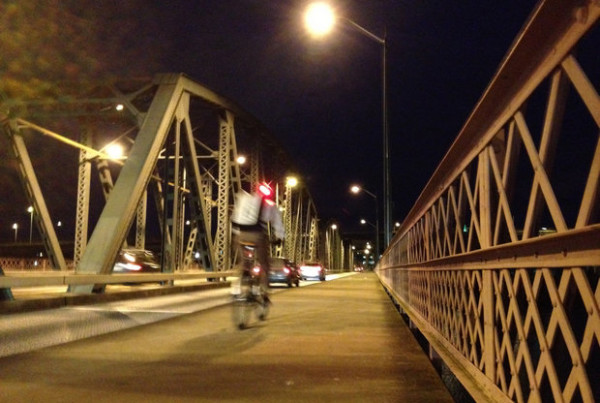The Oregonian: Portland Bike Plan goes before City Council, but can the city afford it?
By Joseph Rose, The Oregonian
February 02, 2010, 8:47PM
The 2030 Portland Bicycle Plan, envisioning a future when 25 percent of trips are made by bike, is expected to coast to approval when it goes before the City Council on Thursday.
It’s easy to green-light America’s most ambitious investment in bicycling when it would be funded down the road. But according to city transportation officials, the plan to build 681 miles of new bikeways over the next 20 years will eventually cost $613 million.
By comparison, the MAX Green Line cost $575 million, and all transportation projects in the metro area add up to about $630 million a year.
Portland Mayor Sam Adams doesn’t flinch at the estimated cost. He talks of making neighborhoods more livable, transportation more affordable and reducing greenhouse gas emissions 80 percent by 2050.
“Can we do those things without this bike plan?” Adams said. “I think it would be very difficult.”
Critics think the mayor and cycling advocates are dreaming. For starters, the plan would require a new steady revenue stream.
“They want to make bicycling more attractive than driving for all trips of three miles or less,” said John Charles, president of the Cascade Policy Institute. “Nothing they do is going to make that happen for most people.”
The plan calls for an expansive interconneted bicycle network, new street designs and an array of education programs. It also mandates studying “funding concepts” in coming months.
Some ideas – licensing and registration fees for bicyclists, a citywide sales tax on new bikes and advertising in bike lanes – would target just cyclists. But a proposed “green transportation” bond would ask everyone to pay.
Even with the economy dragging, the bike plan is optimistic about property-tax increases because “Portland residents have repeatedly shown strong support for funding sustainable or green spaces initiatives.”
With hope, some city officials point to Washington County. There, voters have repeatedly approved new property taxes to build 123 miles of bike lanes through the Major Streets Transportation Improvement Program. Of course, that 25-year-old road tax has always benefited more than one mode of commuting.
From the widening of Oleson Road to the Verboort roundabout, every improvement includes sidewalks for pedestrians and bike lanes (or at least wider shoulders) for cyclists. “Everyone chips in,” said county spokeswoman Anne Madden, “and everyone benefits.”
By 2012, the Washington County program’s $555 million in property-tax revenue is expected to have completed 111 projects on what were narrow farming roads a century ago.
By contrast, the 2030 Portland Bike Plan for the most part calls for separate funding sources for two-wheeled commuters.
Portland’s first Bicycle Master Plan was adopted in 1996. With only modest investment, the bicycle network has since doubled to more than 300 miles and bike commuting has boomed.
Last fall, the Census Bureau’s annual American Community Survey data showed 6.4 percent of Portlanders reported bicycling to work in 2008, a big jump from 4 percent the year before.
The 2030 Bike Plan projects an uptick of 400 percent. To do that, the city is trying to appeal to Portlanders say they who want to commute by bike but don’t think it’s safe enough.
Through years of surveys and public outreach, PBOT has categorized 60 percent of residents as “interested but concerned” in bike commuting.
Where the 1996 plan emphasized bike lanes on busy streets, the 2030 plan proposes 314 miles of new separated bikeways and 256 miles of new bike boulevards with low automobile traffic that link to key destinations. It also calls for more bike parking and increased maintenance budgets.
The new plan offers a heavenly two-wheeled vision of Portland in 2030 – “a clean, thriving city where bicycling is a main pillar of the transportation system and more than a quarter of all trips are made on bicycles.”
It also quotes H.G. Wells: “Cycle tracks will abound in Utopia.”
But one might think of George Orwell after visiting the city’s official bike plan web site, which encourages visitors to “click here to express your support.”
Oppose the plan? Have legitimate concerns about it? Sorry. No link for you.
Since the public comment period opened in October, the Portland Bureau of Transportation city has received 202 comments. Only 17 have been “clearly against” the plan.
Still, given the city’s shaky transportation budget and the fact that the so-called “Copenhagen on the Willamette” already is considered a world-class bicycling city, some wonder if the plan is even needed.
Charles wonders why, when technology and culture are changing at a rapid pace, Portland is planning 20 years into the future. He compared it to a business in 1980 committing to 20 years of IBM typewriter purchases, unaware that the computer revolution was on the horizon.
Near Charles’ office in Raleigh Hills, Southwest Scholls Ferry Road turns treacherous once Washington County’s bike lanes and wide shoulders stop at the Portland city limits.
Although a multimodal property tax such the one supported by Washington County voters isn’t in the bike plan, one city official said Portland is exploring the possibility of “something similar.”
At the same time, Geller said there will several opportunities for future federal funding. When Congress undertakes the reauthorization of the surface transportation bill, for example, the city is expected to ask for $25 million for a citywide bicycle boulevard program.
More than $600 million for bicycle improvements “is definitely a big number and I appreciate that,” Geller said. “But in transportation dollars, it goes a long way.” By contrast, he said, “It would build only about 12 miles of urban freeway.”

